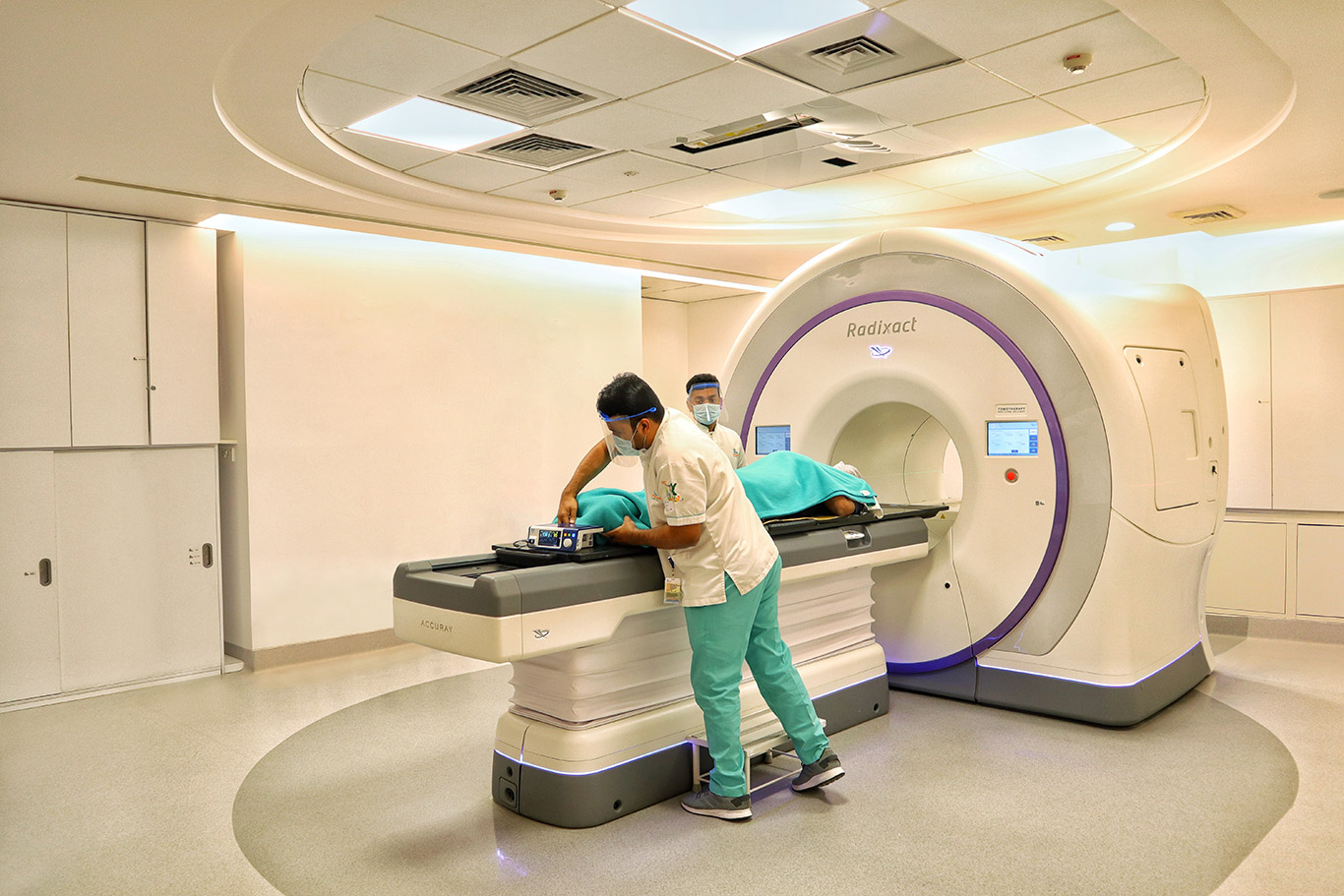Radiation therapy is a form of cancer treatment where cancer cells are destroyed using high-energy X-rays or particles such as protons. It is a painless and non-invasive local treatment which damages the DNA of the cancer cells and leads to death of the cancer cells in the area irradiated. It is usually given from a machine outside the body (called external-beam radiation therapy). It is one among the pillars of cancer treatment (others being surgery, chemotherapy, precision oncology, immunotherapy) which has been used for more than a century.
- What is radiation therapy?
-
- What happens during radiation therapy?
-
High-energy X-rays/ particles are focused using precision technology and machines onto the tumour. This radiation damages the DNA of the cancer cells and prevents them from multiplying. The body then clears these dead tumour cells through various mechanisms.
- Why do cancer patients need radiation?
-
Radiation therapy can destroy tumours by directly killing the cells and also by damaging DNA of the cancer cells by the production of free radicals and/or prevent them from returning. It can be used by itself as the only treatment or in combination with surgery, systemic therapy (such as chemotherapy, targeted therapy and immunotherapy), or both. Sometimes radiation is used to shrink a tumour before surgery (neoadjuvant therapy) or given after surgery to halt the growth of remaining cancer cells (adjuvant therapy). Radiation may also be combined with chemotherapy (concurrent chemoradiation) to destroy cancer cells.
- What is the success rate of radiation therapy?
-
It has been proven to be successful in curing or controlling many cancers, when used appropriately. Success after radiation therapy depends on the type and stage of cancer treated. Some types of cancer cells are very sensitive to radiation and radiation alone may be used to treat such cancers. In some early stage cancers (e.g. cervical cancer, lymphomas, prostate cancer), radiation therapy alone can often be used with curative intent offering cure rates of approximately 90%. In other cancers, when used along with chemotherapy or surgery, radiation therapy increases the cure rate of these cancers ( E.g. breast cancer, some head and neck cancers, esophageal cancer).
- At what stage of cancer is radiotherapy used?
-
Radiotherapy may be used in all the stages of cancer- from the early stages of cancer to the advanced stages (even after it has spread).
It can be used to:
- Try to cure the cancer completely, either alone or in combination with chemotherapy (definitive radiotherapy)
- Make other treatments more effective – for example, it can be combined with chemotherapy or used before surgery (neo-adjuvant radiotherapy)
- Reduce the risk of the cancer coming back after surgery (adjuvant radiotherapy)
- Relieve symptoms if a cure is not possible (palliative radiotherapy)
- Is radiation therapy more expensive than chemotherapy?
-
Chemotherapy and radiation are two of the most common types of cancer treatments. Whether you receive chemo or radiation will depend on the type and location of your cancer, as well as your overall health status. The cost of the therapy also depends upon which therapy is predominantly used in your treatment. The cost of each therapy will also depend on the type of chemotherapy or technique of radiation therapy used and the number of fractions or cycles prescribed.
- What is the success rate of radiation therapy?
-
It has been proven to be successful in curing or controlling many cancers, when used appropriately. Success after radiation therapy depends on the type and stage of cancer treated. Some types of cancer cells are very sensitive to radiation and radiation alone may be used to treat such cancers. In some early stage cancers (e.g. cervical cancer, lymphomas, prostate cancer), radiation therapy alone can often be used with curative intent offering cure rates of approximately 90%. In other cancers, when used alongwith chemotherapy or surgery, radiation therapy increases the cure rate of these cancers ( E.g. breast cancer, some head and neck cancers, esophageal cancer).
- What is the purpose of radiation therapy?
-
Radiotherapy is a treatment where radiation is used to kill cancer cells.
- What are the advantages of radiation therapy?
-
Radiation therapy is a highly precise treatment, aimed accurately and directly at the cancer wherever it might be in the body. This allows the cancer cells to be killed or reduced in number whilst protecting the majority of other organs and tissues in the body. Radiation therapy contributes to 50% of all cancer cures world-wide as well as relieving symptoms, such as pain, and improving the quality of life for many others. Side effects of radiation are generally confined only to the area treated. In some cases, the use of radiation therapy as compared to surgery may cause less damage and the part of the body involved may be more likely to work the way it should after treatment.
- Is radiation better than chemo?
-
Depending on the type of cancer, one of these treatments can be more effective than the other in treating a particular type of cancer. Other times, chemo and radiation can actually complement each other and be given together. When you meet with your cancer care team, your oncologist will give you the options that will be most effective in treating your type of cancer.
- What are the long term side effects of radiation?
-
The type of radiation side effects you might have depends on the prescribed dose and schedule. Most side effects go away within a few months of ending treatment. Some side effects may continue after treatment ends because it takes time for the healthy cells to recover from radiation. Careful treatment planning and high-precision technology can help avoid serious long-term side effects. It’s always best to talk to your radiation oncologist about the risk of long-term side effects.
- Does radiation lower your immune system?
-
Radiation therapy can potentially affect your immune system, especially if a significant amount of bone marrow is being irradiated because of its role in creating white blood cells. However, this doesn’t typically suppress the immune system enough to make you more susceptible to infections.
- Is radiation treatment painful?
-
Not really. Most patients have no sensation of radiation when the machine is delivering the daily treatment. A few patients report a slight warming or tingling sensation in the area while the radiation machine is on. Over time, the skin in the area being treated will gradually become dry, sore, itchy, or burning. These feelings can be uncomfortable, but usually not enough for a person to stop or interrupt her treatment.
- What are the disadvantages of radiation therapy?
-
The disadvantages of radiation therapy may include damage to surrounding tissues (e.g. lung, heart), depending on how close the area of interest is located to the tumour, inability to kill the all cancer cells in tumours (this is true in particular for large tumours), increased incidence in wound complication and poor healing (e.g. if surgery is used after radiation; or in parts without good circulation), inconvenience of radiation therapy (e.g. in some cases it must be delivered daily, 5 days per week, for 1-2 months) and contraindications to radiation therapy (e.g. prior radiation; certain medical disorders)
- What should you avoid during radiation?
-
It’s always best to talk to your radiation oncologist about the precautions required during radiation therapy. However, there are certain precautions that one should take during radiation therapy including:
- Avoid using harsh detergent soap and hot water to clean the area receiving radiation.
- Avoid rubbing, rather pat the region dry whenever required.
- Avoid prolonged or direct sunlight on the treated area.
- Don’t remove ink marks unless your radiation therapist says it’s OK.
- Don’t use hot tubs, saunas, heating pads, or ice packs, unless advised by your radiation oncologist.
- Don’t wear tight clothing that causes friction or rubbing on the skin.
- Don’t shave your beard/moustache if you’re undergoing radiation therapy of the head and neck region.
- Avoid spicy food in the diet.
- You may be asked to avoid certain foods in your diet to avoid excessive gas formation, as per the special protocols in certain treatments (cauliflower, broccoli, cabbage, lentils, etc.)
- You may be asked to follow special protocols during the planning process and treatments, such as bladder filling protocols, gastric emptying protocol as well as breath-hold protocols. These are patient-specific and detailed instructions that will be given to you individually- please ensure you follow these instructions, as they are essential to ensure the highest quality of radiation treatments.
- SIMULATION
-
Before you begin radiation treatment, your radiation therapy team carefully plans your treatment in a process called radiation simulation. Treatment planning usually involves positioning your body, making marks on your skin and taking imaging scans.
Your radiation therapy team determines whether you’ll lie on your back, stomach or side during treatment. It’s crucial to find a position that optimizes your treatment, but is comfortable enough to hold for 15 to 45 minutes.
A variety of immobilizers may be used to ensure you’ll be in the same position for each radiation therapy treatment. Usually, a cushion mould or a mask may be made for your immobilization.
- MARKING
-
The radiation therapy team uses a combination of laser lights and marks on your body. This ensures that your body is precisely aligned and positioned properly for each treatment session. What type of mark you receive depends on your cancer and your treatment. In certain cases, marks are drawn on your skin with a marker and a clear sticker is used to make sure these marks don’t wash off. Please do not remove these stickers till your treatment is done. You can wash these marks off once your final treatment is completed.
- IMAGING
-
Once you’re correctly positioned, the radiation therapy team takes computerized tomography (CT) images of the area of your body to be treated. This helps your radiation oncologist determine the exact areas where treatment will be focused. An MRI scan or a PET scan may also be taken to aid your radiation oncologist in target delineation.
- COMPUTERISED PLANNING
-
Your images are then sent to the treatment planning system (TPS) where your radiation oncologist delineates the exact tumour boundaries and the volume of tissue to be treated with radiation therapy. Thereafter the physics team plans your treatment to delivered on the machine best suiting the dose prescribed by your radiation oncologist.
- QUALITY ASSURANCE
-
After a plan is generated, it is verified by a quality assurance test on the treatment machine before being delivered to the patient. This is to confirm that what has been planned by the TPS is ultimately what is delivered to you.
- What To Do Before Radiation Therapy?
-
It can be hard to know how to prepare, but a number of general issues are worth considering in advance.
- Arrange accommodation
Talk to our care coordinators who will be happy to provide you with options for accommodation, both within and outside the hospital. - Arrange transport
Talk to our care coordinators or reception desk about parking arrangements as there will often be spots set aside for radiation therapy patients. - Quit Smoking
If you smoke, try to quit or cut down before radiation therapy starts as smoking may make the treatment less effective and side effects worse. - Mention Metal Implants
Let your treatment team know if you have any medical devices in your body, such as a pacemaker, cochlear implant, or another metal implant. Radiation therapy can affect these devices. - Previous imaging
Do remember to bring most (if not all) of your previous imaging reports (and films/CDs if available) to your first consult so your physician can have all the information available to decide the best plan of treatment. - Consider Fertility
Some types of radiation therapy can affect your fertility. If you think you may want to have children in the future, talk to your treatment team about your options before radiation therapy begins. If you think you may be pregnant, do mention this before radiation therapy planning/simulation is done. - Having/trimming facial hair
If you are receiving radiation therapy to your face/neck, you may want to consider trimming your beard/moustache or shaving before beginning radiation therapy, as you would need to avoid these during treatment.
- Arrange accommodation
- How radiation therapy is done?
-
Radiation therapy can be given in 3 ways:
- External radiation (or external beam radiation)
Uses a machine that directs high-energyrays from outside the body into the tumour. It’s done during outpatient visits to a hospital or treatment centre. It’s usually given over many weeks and sometimes will be given twice a day for several weeks. A person receiving external radiation is not radioactive and does not have to follow special safety precautions at home. - Internal radiation
Internal radiation is also called brachytherapy. A radioactive source is put inside the body into or near the tumour. With some types of brachytherapy, radiation might be placed and left in the body to work.
Sometimes it is placed in the body for a period of time and then removed. This is decided based on the type of cancer. Special safety precautions are needed for this type of radiation for a period of time.But it’s important to know if the internal radiation is left in the body, after a while it eventually is no longer radioactive. - Systemic radiation
Radioactive drugs given by mouth or put into a vein are used to treat certain types of cancer. These drugs then travel throughout the body.You might have to follow special precautions at home for a period of time after these drugs are given. - The type of radiation you might get depends on the kind of cancer you have and where it is. In some cases, more than one type is used. Your cancer care team can answer specific questions about the type of radiation prescribed for you, how it affects your body, and any precautions that may be needed.
- External radiation (or external beam radiation)
- How has radiation therapy technology evolved over time?
-
Radiation therapy has played an important role in the treatment of cancer for more than a century. The aim of radiation therapy has always been to eradicate a patient’s cancer by delivering high dose of radiation to the tumour while delivering minimal doses to surrounding normal organs.
Advancements in technology and engineering has improved the delivery of radiation to make it more precise, and radiation oncologists are now able to deliver higher doses of radiation more safely.
Unlike early telecobalt machines that used low-energy X-rays with consequent higher side effects to the skin and surrounding normal tissues, today, radiation oncologists utilize high-energy, megavoltage X-rays delivered using linear accelerators that can penetrate more deeply and minimize irradiation of the skin. The advent of several engineering advancements, such as computerised treatment planning systems, multi-leaf collimators (MLC’s) and cone beam computed tomography imaging panels mounted on the treatment units, allow the treatments to be more conformal to the tumour and thereby eliminate side effects due to irradiation of nearby normal tissues. The advancements have also become more and more patient friendly by reducing the time spent on the machine.
The next phase of technology that is becoming more prevalent is proton therapy, the most advanced form of radiation available. Unlike high-energy X-rays which pass through the body of the patient with progressively decreasing intensity, proton beams come to stop at a particular depth within the patient (depending on the energy of the beam). Hence, proton beams are much more precise than high-energy X-rays. Pencil beam scanning, also known as spot scanning, has the ability to treat complex tumours while avoiding healthy tissues and critical structures thereby improving patient’s quality of life without compromising on patient outcomes.
- TomoTherapy
-
About TomoTherapy
TomoTherapy System is designed to safely and routinely deliver image-guided, intensity-modulated radiation therapy (IG-IMRT) for the treatment of cancer and other diseases. What has made the TomoTherapy System stand out whe compared to conventional radiation systems is the integration of computed tomography (CT) scanner to perform daily imaging before each treatment session. The daily imaging capability makes it possible for clinicians to identify and correct for any variations in patient positioning, changes in the tumour, or other factors, such as weight gain or loss, to ensure the continued precise and safe delivery of the radiation dose to the target area. Because the TomoTherapy System’s precision minimizes the exposure of radiation to surrounding healthy tissue, many doctors report that their
patients suffer from fewer side effects compared to patients receiving conventional forms of radiation therapy. The precision may enable the TomoTherapy System to be used to treat patients who have had radiation therapy before if their cancers have returned using the re-treatment functionality.Why Does Precision Matter?
Technological advancements have enabled manufacturers of external-beam radiation therapy equipment to improve the precision of their deliverysystems.
In general:
1. The radiation beam needs to enter and exit the body
2. The device design limits how radiation beams can be directed into the body
3. The device may deliver some radiation to the tissue surrounding the tumour because of tumour motion during treatment
Tomotherapy provide continuous delivery of radiation from 360 degrees around the patient, or delivery from clinician-specified beam angles. These unique features, combined with daily 3D image guidance, enable physicians to deliver highly accurate, individualized dose distributions that precisely conform to the shape of the patient’s tumour while minimizing dose to normal, healthy tissue, resulting in fewer side effects for patients. The system helps in treating all standard radiation therapy indications including breast, prostate, lung, and head and neck cancers, in addition to complex treatments, such as total marrow irradiation.Benefits
Patients are hugely benefited by the new generation of TomoTherapy.
- Daily
imaging helps the doctor to see their tumour shrinkage everyday, helping them to restrict the dose to the tumour/cancer and not the healthy tissue resulting in fewer complications and by far superior tumour control - Low CT imaging dose with Iterative imaging even helps patients with metal implants such as dentures, a pacemaker or orthopedic implants to get highly accurate treatments as imaging can be done without artifacts.
- High local control of tumour
- Least dose to the healthy tissue and normal anatomical organs such as eyes, lungs,heart, kidneys, parotid glands and other organs fulfilling important functions within the body etc
- High survival rate – Least complications or side effects of radiation treatment
- High local control of tumour
- Least dose to the healthy tissue and normal anatomical organs such as eyes, lungs, heart, kidneys, parotid glands and other organs fulfilling important functions within the body etc
- Highsurvival rate
- Least complications or side effects of radiation treatment
- Targeted treatments become a reality
- Dose is restricted to the target or the tumour
- Complicated and paediatric treatments can be treated with confidence
Treatment field size
Large field cancer is common in the field due to late diagnosis and it’s often that patient ends up with a large tumour/ cancer or at multiple sites:
- Without junction means no overlapping dose and thus resulting in highly conformal treatments and least complications and side effects due to high dose to healthy tissue or organs incase of regular linac based treatment
- The most complicated treatment needs are straight forward and have a simplified workflow meaning high patient comfort and far superior outcomes
This is an important requirement in the region as the majority of the patients in the region as per the reports require large field treatments because of the below factors:
- The region has a poor detection rate with only 20-30% of cancer diagnosed in Stage 1 & 2
- The region
has a higher incidence of Prostate, head and neck, lung, breast & GI cancers making upto 80-90% of cancer in the region and that’s where TomoTherapy has by far superior treatment results
Range of Indications Covered
- Brain cancers and benign brain tumours
- Head, neck and oral cancers
- Breast cancers, including inflammatory breast disease (both Unilateral & Bilateral)
- Lung cancers and lung tumours
- Skin cancers
- Prostate cancer, from early-stage to advanced disease
- Oesophageal and upper gastrointestinal cancers
- Cervical,ovarian, uterine, vaginal and vulva cancers
- Colon,stomach, rectal and anal cancers
- Liver and pancreatic cancers
- Cancers that have metastasized to multiple locations
- Pre-transplant treatment for blood diseases, such as leukaemia
- Daily
- Life After Radiation Therapy
-
Radiation therapy usually does not have an immediate effect, and it could take days, weeks or months to see any change in the cancer. The cancer cells may then keep dying for weeks or months after the end of treatment. It may be some time before you know whether the radiation therapy has controlled the cancer. Life after cancer treatment can present its own challenges. You may have mixed feelings when treatment ends, and worry that every ache and pain means the cancer is coming back.
Some people say that they feel pressure to return to “normal life”. It is important to allow yourself time to adjust to the physical and emotional changes, and establish a new daily routine at your own pace. Your family and friends may also need time to adjust.
- What happens to a tumour after radiation?
-
When the damaged cells die with radiation, they are broken down and removed by the body. Radiation therapy does not kill cancer cells right away.
- How long does it take radiation to shrink a tumour?
-
It takes days or weeks of treatment before DNA is damaged enough for cancer cells to die. Then, cancer cells keep dying for weeks or months after radiation therapy ends.
- Do tumours grow back after radiation?
-
Sometimes cancer can become resistant to treatment. Cancers develop from normal cells that have changed or mutated to become cancerous. The mutation happens in the genes of the cell. These gene changes make the cell behave differently to a normal cell. Cancer cells can continue to mutate so that they become more and more abnormal.
Some mutations can make the cells resistant to cancer drugs such as chemotherapy, targeted cancer drugs, hormone therapy or Radiation Therapy. You can sometimes have a different type of treatment if this happens.

Winning over Cancer with Apollo Proton Cancer Centre
A breakthrough in Cancer Care! The global growing cancer burden tells an ominous tale. To counter this growing threat, Apollo Proton Cancer Centre provides a complete and comprehensive solution. As cancer care has become one of the fastest-growing healthcare imperatives across the world, we believe it is critical to redefine our purpose, to reboot our commitment on the single-minded focus – to battle cancer, to conquer cancer! APCC stands as a ray of hope for millions, infusing them with the courage to stand and stare cancer down.

Copyright © 2025 Apollo Proton Cancer Centre. All Rights Reserved





